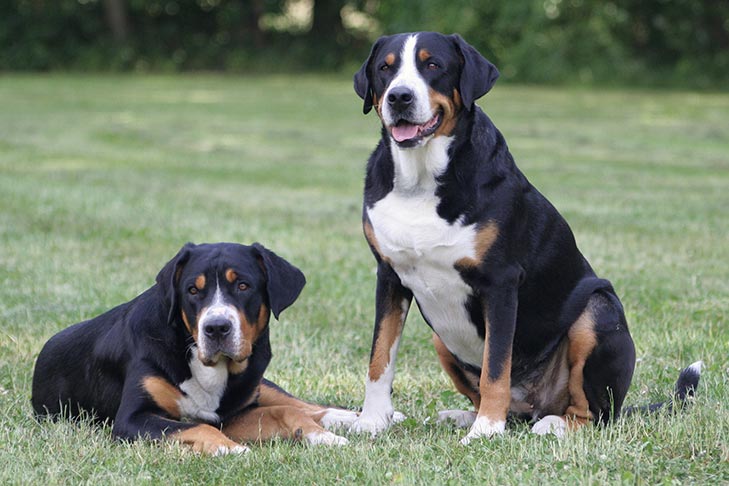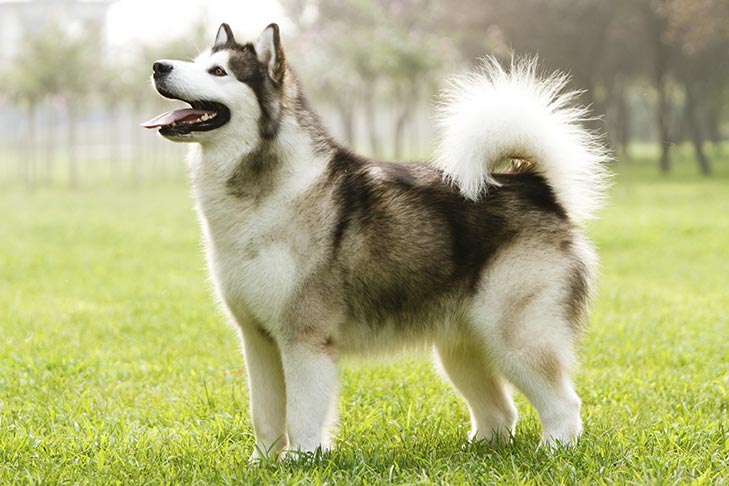
From double to single, long to hairless, and curly to wiry, dogs’ coats come in different textures, lengths, and colors. But what exactly are double-coated dogs?
Defining Double-Coated Dogs
Double-coated dog breeds have coats made up of two different layers. The first, outermost layer is a harsh topcoat that consists of long, coarse hairs. A topcoat may also be called guard hairs or primary hairs. Beneath the topcoat is the short, soft, and dense second layer, usually referred to as the undercoat. Often woolly in texture, the undercoat can also be called as wool or secondary hairs.
Both the topcoat and the undercoat serve practical purposes. The topcoat can keep water and dirt off your dog. The undercoat can provide insulation in cold weather, keeping dogs warm all fall and winter long. When the weather gets warm in the spring and summer, the undercoat traps cool air against the skin. That way, the dog won’t overheat.

The topcoat and undercoat are different in structure and function. The topcoat consists of three different layers, and its hairs are often very strong. Dogs shed their topcoats less than they shed their undercoat. In contrast, your dog will shed their undercoat (which isn’t as strong) more often, especially as the seasons change. The topcoat helps protect a dog’s skin, repelling water and other elements, and its hairs give your dog their color, while the undercoat may grow at different rates and lengths.
A dog may have more undercoat than topcoat or more topcoat than undercoat. If the undercoat is denser than the topcoat, it gives the dog a fluffy appearance. While some people like the look of a cottony coat, a double coat in dogs means there’s a lot more to comb out during shedding season.
Types of Double Coats
According to certified master groomer Jennifer Bishop-Jenkins, there are four different types of double coats in dogs. The type of double coat depends on the dog’s breed and what the dog was originally bred to do. The types of double coats in dogs are short, medium, long, and triple (or arctic).
“Recognizing your dog’s coat type is so important when grooming your dog,” says Bishop-Jenkins. “There are different ways to groom a dog, depending on its coat type. The last thing you want to do is remove hair that will never grow back or neglect a coat that mats and won’t give your dog any protection from harsh weather.”
Short Double Coats
Breeds that have short double coats include the Labrador Retriever, Greater Swiss Mountain Dog, Cardigan Welsh Corgi, and Pembroke Welsh Corgi. A dense outercoat protects these breeds from the cold weather and dense brush, which they might encounter while hunting game or herding livestock. This coat doesn’t require any trimming. However, you should comb these coats weekly to remove loose hair, since dogs shed their undercoat.

Medium Double Coats
Breeds with medium double coats include herding dogs such as Border Collies and Australian Shepherds. It’s a good idea to brush medium double coats weekly, both to prevent mats and to remove loose fur. You may also choose to trim any excess hair on the feet, hocks, and pasterns, depending on what the breed standard calls for.
Long Double Coats
Working breeds like Newfoundlands, Bernese Mountain Dogs, Great Pyrenees, and Saint Bernards have flat, water-resistant topcoats and thick undercoats. These breeds may require more trimming on their chests, around the ears, undercarriage, on the back of their legs, and tail, as specified by their breed standards. “Comb the top of the head to keep it from matting,” advises Bishop-Jenkins, “but never shave it because the hair won’t grow back.”
Triple or Arctic Coats
Dogs with the thickest coats include the Pomeranian, Samoyed, American Eskimo Dog, Alaskan Malamute, and other breeds native to the Arctic or other northern climates. According to Bishop-Jenkins, these breeds historically depended on an extra layer of undercoat to help them survive and reproduce in very cold temperatures.
Triple coats are so thick and have such a dense, oily, and woolly undercoat. In fact, if you just try to comb these coats, you’ll rip the hair. The best way to groom dogs with an arctic coat is to use a high-velocity dog dryer after you have bathed, brushed, and line combed your dog (which involves getting rid of the loose undercoat hairs).

Although line combing can be time-consuming, it’s a gentle way of detangling your dog’s coat, since you’re working upwards and forward, line by line, to lift and remove loose hair. You’ll also want to avoid drying a triple coat all the way to the skin.
To Shave or Not to Shave
When the weather warms up, some people think shaving their dogs help cool them off and stop the shedding. However, when you’re grooming them regularly, you shouldn’t shave double-coated dogs. After all, shaving removes both the undercoat and topcoat. Since both coats do not grow at the same rate, the undercoat can overtake the outer coat, and the dog will wind up with too much undercoat.
“Shaving doesn’t do anything to cool dogs off because a dog’s cooling system is different than ours,” says Teri Becker DiMarino, President of the California Professional Pet Groomers Association. Dogs sweat through the pads of their feet and cool themselves off by panting.
Shaving them doesn’t cool them down, Becker DiMarino says. If you shave down your dog’s double coat, there’s also the chance that hot clippers might burn their skin. There are only two reasons to shave a dog: if the dog is undergoing surgery or, as a last resort, if a dog’s coat is so neglected and severely matted that you can’t brush it.

Other problems can result from shaving your dog’s undercoat. Shaving down the undercoat removes the dog’s natural cooling protection, making the dog more vulnerable to overheating. Shaving the undercoat also exposes your dog’s skin exposed to harmful UV rays. Even if you use canine sunscreen, your dog may still experience sunburn and could even develop dog skin cancer. Without a coat to protect the skin, other dermatological problems, ranging from dry, flaky skin to ingrown hairs, may appear. Shaved skin can also make your dog more vulnerable to external parasites like fleas and ticks.
If a coat (particularly a double coat) is neglected and tangled, Bishop-Jenkins recommends a step-by-step process. First, you wet the dog, pre-soaking the coat with a thick, creamy dog conditioner, then you massage the dog conditioner into the coat. Let the solution soak for a good hour, she says.
Before washing out the conditioner with dog shampoo, she advises aiming a high-velocity canine blow dryer at the skin. “The air on the dryer will penetrate the undercoat and push the matted coat,” she explains. “Follow with shampoo and conditioner.”
Grooming Tips to Keep Dogs Cool

Rather than shaving your dog, keep them cool during the summer by routinely bathing, brushing, and combing them with the right grooming equipment. Here are some warm-weather grooming tips:
- Use a grooming rake or a quality steel comb.
- Use a slicker brush on areas with a lot of hair.
- To prevent mats, comb your dog two or three times a week.
- Use a wide-tooth steel comb to carefully detangle mats.
- If the teeth on a comb bends out of shape, replace the comb.
- Use dog grooming tools that fit your hand comfortably and get the job done efficiently and safely.
If your pet gets hot in the summer, there are lots of different ways to keep your dog cool. Consider using a dog cooling vest or dog cooling bandana, or your dog might enjoy relaxing on a dog cooling mat.

